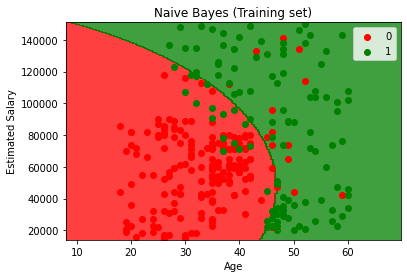#What is Naive Bayes algorithm?
Naive bayes is a classification technique which relies on bayes theorem. Bayes theorem provides an equation describing the relationship of conditional probabilities of statistical quantities..In simple terms, a Naive Bayes classifier assumes that the presence of a particular feature in a class is unrelated to the presence of any other feature.
Let us understand this with an example. Consider a watermelon. What are the physical features of a watermelon: green, round and huge. Considerably, these features describing a watermelon depend on each other for their existence,all of these properties independently contribute to the probability that this fruit selected at random is a watermelon.This is why the term “Naive” is used.
Naive Bayes models are easy to build and can be used for initial verifications for large datasets. Because of its simplicity, it is equally easy to explain the functionality or working in the background. Before we dive into an example on how to use it in machine learning. Let;s wrap our heads around the formula.
In Bayesian classification, we’re interested in finding the probability of a target given some observed features, which we can write as P(Target | features)
For computation,Bayes theorem can be written as :
P(Target | features) = P(features | Target ) x P(Target) / P(features)
And if we have two targets, say T1, T2, the computations can be represented as :
P(T1 | features) / P(T2 | features) = P(features | T1) x P(T1) / P(features) / P(features | T2) x P(T2) / P(features)
#When to use it?
Due to the naive assumption made, these models do not perform well on complex datasets. However, below are few advantages of using this classification method
- They are extremely quick to train and make predictions.
- The Explainability score is very high.
- Very few parameters to tune and make the model perform better.
- They provide straightforward probabilistic prediction.
These advantages make the Naive Bayesian model a good baselines classification that is easy to set up and takes very less training time. In situations described below, Naive Bayes often outperforms other complex models in its simplicity :
- The naive assumptions correlate with the data.
- Well separated target attributes.
- High dimensional data, where model complexity is less important.
#Code it up!
scikit learn library provides us with three different types of Naive Bayes models:
- Gaussian : Used for classification, with assumption of normal distribution of features.
- Multinomial : Used for discrete counts.
- Bernoulli : Useful if your feature vectors are binary (i.e. zeros and ones). One application would be text classification with the ‘bag of words’ model where the 1s & 0s are “word occurs in the document” and “word does not occur in the document” respectively.
We consider the dataset, Social media Ads, which has two attributes: age and income and a target with value [0,1] describing whether they bought the car or not.
dataset = pdpp.read_csv('Social_Network_Ads.csv')X = dataset.iloc[:, :-1].valuesy = dataset.iloc[:, -1].valuesSince the two attributes are of diverse values, we need to use StandardScaler.
from sklearn.preprocessing import StandardScalersc = StandardScaler()X = sc.fit_transform(X)Splitting the dataset for training and testing.
from sklearn.model_selection import train_test_splitX_train, X_test, y_train, y_test = train_test_split(X, y, test_size = 0.25, random_state = 0)Importing the GaussianNB from Naive bayes model
from sklearn.naive_bayes import GaussianNBclassifier = GaussianNB()classifier.fit(X_train, y_train)Let’s understand how our model performed.
from sklearn.metrics import confusion_matrix, accuracy_scorecm = confusion_matrix(y_test, y_pred)print(cm)[[65 3]
[ 7 25]]
accuracy_score(y_test, y_pred)0.9
Visualizing training set results of the model will help us understand the model behavior and decision
from matplotlib.colors import ListedColormapX_set, y_set = sc.inverse_transform(X_train), y_trainX1, X2 = np.meshgrid(np.arange(start = X_set[:, 0].min() - 10, stop = X_set[:, 0].max() + 10, step = 0.25), np.arange(start = X_set[:, 1].min() - 1000, stop = X_set[:, 1].max() + 1000, step = 0.25))plt.contourf(X1, X2, classifier.predict(sc.transform(np.array([X1.ravel(), X2.ravel()]).T)).reshape(X1.shape), alpha = 0.75, cmap = ListedColormap(('red', 'green')))plt.xlim(X1.min(), X1.max())plt.ylim(X2.min(), X2.max())for i, j in enumerate(np.unique(y_set)): plt.scatter(X_set[y_set == j, 0], X_set[y_set == j, 1], c = ListedColormap(('red', 'green'))(i), label = j)plt.title('Naive Bayes (Training set)')plt.xlabel('Age')plt.ylabel('Estimated Salary')plt.legend()plt.show()from matplotlib.colors import ListedColormapX_set, y_set = sc.inverse_transform(X_test), y_testX1, X2 = np.meshgrid(np.arange(start = X_set[:, 0].min() - 10, stop = X_set[:, 0].max() + 10, step = 0.25), np.arange(start = X_set[:, 1].min() - 1000, stop = X_set[:, 1].max() + 1000, step = 0.25))plt.contourf(X1, X2, classifier.predict(sc.transform(np.array([X1.ravel(), X2.ravel()]).T)).reshape(X1.shape), alpha = 0.75, cmap = ListedColormap(('red', 'green')))plt.xlim(X1.min(), X1.max())plt.ylim(X2.min(), X2.max())for i, j in enumerate(np.unique(y_set)): plt.scatter(X_set[y_set == j, 0], X_set[y_set == j, 1], c = ListedColormap(('red', 'green'))(i), label = j)plt.title('Naive Bayes (Test set)')plt.xlabel('Age')plt.ylabel('Estimated Salary')plt.legend()plt.show()#Improving Naive Bayes
- Transform continious features into normal distribution.
- USe Laplace Estimator in cases of zero frequency problem.
- Focus on pre processing and feature selection to optimize the results of Naive Bayes.
- Do not spend time applying bagging boosting or ensemble method on Naive Bayes, as it has no variance to minimize.
I hope you found this article useful. To follow the code, I have created a sample notebook. Feel free to make a copy of the notebook for your experiments. Do let me know if you have any questions!


